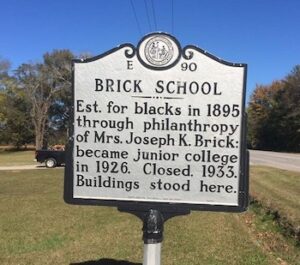
Brick Junior College Plaque
*Brick Junior College was established on this date in 1895. This Black school, founded after the American Civil War, was the first accredited African American school in North Carolina.
The American Missionary Association founded the Joseph Keasley Brick Agricultural, Industrial, and Normal School. Land and money for buildings came from Julia Brick, a wealthy Brooklyn widow, who named the school for her husband. Principal Thomas S. Inborden opened the school for 54 students, all in the first four grades. The curriculum required all students to take an industrial class. Inborden believed girls should be proficient in "the use of the needle" and boys "with the handling of tools."
Students assisted with maintaining the campus while also receiving a standard arts and science education. The junior college opened in 1925, and 24 students were admitted by certificate from approved high schools or by examination from non-approved schools. A year later, 12 students returned, and 25 new students joined. Those in the Arts and Science program were required to take 12 credits each in English and history, 10 in chemistry, 3 in algebra and trigonometry, and 24 from among education, French, Latin, biology, analytic geometry, or differential calculus.
Those in pre-medicine were required to take 15 credits of chemistry, 12 of French, 8 of physics, and four of zoology. SACS regionally approved Brick Junior College. Total enrollment was 350 in 1920. It had been as high as 460. By 1926, it was down to 259—81 elementary students, 241 in high school, and 37 in junior college. However, the Great Depression cut both enrollment and funds. The total school enrollment was down to 168, while AMA funds were cut by 45%. The school had to close its doors in 1933.
It was one of a few Black colleges in the South accredited by the Southern Association of Colleges and Schools at that time. The AMA's Fred L. Brownlee convinced the Association's directors to retain the 1,100-acre farmland and rent it to student farmers. A few years later, the state took over the school, and the AMA started the Brick Rural Life School to train rural families to have successful rural lives. Neill A. McLean became principal of the school in 1934. A credit union was established the following year.